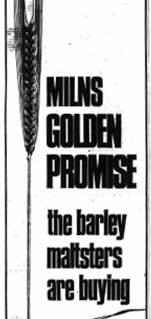Glen Mhor Golden Promise
There's no better proof of what barley type a distillery was using than appearing in an advert for the said grain across multiple years.
The advertisement is below and appeared in the Aberdeen Press & Journal on 12th December 1968 and 16th January 1969. names mentioned include William Grant & Sons, Highland Distillers and Scottish Malt Distillers. Underlying its widespread use and also included on this list are Mackinlays & Birnie Limited, meaning that Glen Albyn and Glen Mhor were following suit.
Also, we can take note that when D.C.L. purchase both distillers in 1972 and Scottish Malt Distillers ran the sites, the type of malt would have been consistent.
Golden Promise has passed into the history books nowadays, replaced by more efficient strains of grain; such is the way of things in this sector. Yet it is fondly remembered by many enthusiasts, arguably playing a role during a classic period of Scotch whisky. Its appeal is universal as the (now closed) Japanese distillery, Karuizawa, only used Golden Promise.
Playing a role in its replacement was the concern that Golden Promise was cancerogenic, but as Francis at Daftmill distillery commented to me; you'd had to drink a considerable amount to increase your cancer risk and that quantity, it'd be the alcohol that would kill you!
How much of a key component is the grain in this fondly remembered era? It is outside our own research function, but it might play a part when we come to tasting whiskies from around this time. It endured as the mainstay of fields until the 1980s, which is impressive as varieties of malt come and go more quickly nowadays.
For more information on Golden Promise, I'd suggest reading this article from Simpson's Malt.


Comments
Post a Comment